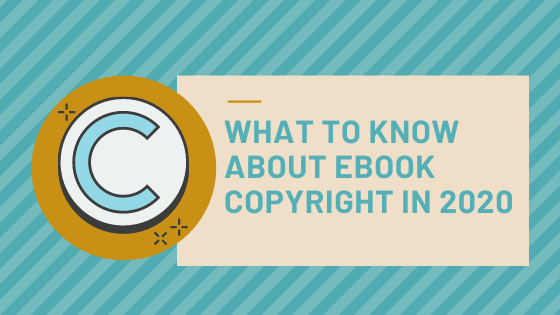Let’s face it—most aspiring authors are more focused on creating a literary masterpiece than thinking about the mundane legal aspects of their book. Writing an amazing manuscript should certainly be the writer’s top priority when undertaking a book project, but careful attention should also be paid to the copyright page of your eBook. After all the hard work spent penning your story, surely you wouldn’t want someone to come along and infringe upon your intellectual property rights.
A copyright can be hard to grasp when it comes to eBooks. We may only associate the need for copyright in relation to a physical book. Since eBooks are a digital commodity—words floating about in space versus printed on paper —you may assume that there is nothing to actually copyright. Alas, this is when you recognize that copyright protects not only the physical property rights of a book but also the intellectual rights of its content.
But wait—doesn’t the law automatically protect our typed words with or without a registered copyright? While true that an author’s work is protected from infringement for 70 years past their death, this can prove to be a toothless law if the author has not taken that next step to further cement their ownership rights. The very simple and inexpensive action of formally registering your eBook’s copyright with the U.S. Copyright Office will offer further legal protections should someone unlawfully copy or sell your content. That is why we have outlined what you need to know about copyright laws, how to register your copyright, and how to write the copyright page.
Important Copyright Laws for eBooks
As the creator of your self-published eBook, you maintain sole rights to the content. Unfortunately, not everyone respects the boundaries imposed by this inherent layer of protection. In other words, someone may pirate and distribute your work as their own. Electronic versions of books are especially vulnerable to these culprits, as it is much easier to swipe and copy digital than traditionally printed content. The following Copyright eBook laws have been enacted to help deter such piracy.
Copyright Laws for eBooks:
- Basic Copyright Protection: By law, only the author, who is the owner of the copyright, has the right to reproduce or distribute the eBook, unless express permission has been granted.
- Digital Rights Management: DRM provides further protections by aiming to prevent such acts as illegal copying, sharing, or selling of the eBook, and helps to enforce the license that accompanies an e-Book when sold. There are various DRM solutions that help protect against piracy, including:
- Adobe encryption
- Watermarking
- Downlink expiration dates
- Digital Millennium Copyright Act “takedown notice”: When it is discovered that content from a copyrighted eBook has been illegally posted online, the copyright holder can submit a DMCA takedown notice to the website service provider demanding the content be removed.
When a copyright holder spots their eBook content being copied, sold, or otherwise used without express permission, they can file a lawsuit for infringement. However, in order to initiate legal action, the book must be registered with the U.S. Copyright Office. Read on to learn how to copyright an eBook.
How Do You Copyright an eBook?
Fortunately, the steps to copyright eBooks are easy to follow and the process itself is not complicated. To register an eBook copyright, follow these steps:
- Go to www.copyright.gov and click on the top left box “Register”.
- Now that you have arrived on the Registration Portal, select the Literary Works option.
- Once you are on the Literary Works page, click the “Register a Literary Work” link on the right.
- This will take you to the user login page. If you do not already have a user I.D. and password, you can register by clicking “If you are a new user, click here to register” which is located in a small type at bottom of the gray box.
- Once logged in, click on the Register a Work “standard application” link on the left.
- Click “Start Registration” at the top.
- For the Type of Work dropdown, select “literary work”.
- Click the agreement box and then the Continue button.
- Click “New”.
- Select the Title Type from dropdown and type in the title of your eBook, then save.
- Complete the rest of the required fields.
- Pay the $35 registration fee.
- Upload the eBook file or zip file. If planning on also publishing a print edition, you are required to ship a print version of the book to the copyright office.
What to Include on a Copyright Page for eBooks
It is surprising just how little information should be included on an eBook copyright page. The bare essentials would include the date of publication, the author’s name, and the phrase “All rights reserved.” While this minimalist version of a copyright page might be appealing, it is definitely not the norm.
Creating a solid and comprehensive copyright page gives your eBook a more professional appearance. Additionally, a well-written copyright page signals that the author takes infringement seriously, which may discourage book piracy.
The copyright page will directly follow the title page in your eBook. There is no hard and fast rule about the exact order of the copyright page elements, but generally, the copyright symbol should appear toward the top of the page, and the ISBN near the bottom. With that said, the author can order the elements as desired.
Here is a list of suggested items to include on your copyright page:
- A disclaimer statement: Although not required, the disclaimer protects the author from liability pertaining to the characters portrayed in the story. A disclaimer may state that the eBook is a work of fiction therefore all characters, places, and events are the product of the author’s imagination. A memoir or nonfiction narrative might include a disclaimer stating that all names and locations have been changed to protect identities.
- Name of the book: This is not required on the copyright page, but some authors do include the title.
- The publisher’s address: If using a self-publishing platform, that contact information can be included on the page. If not, the author’s name and email address or website can be listed.
- The copyright symbol: The copyright symbol should be followed by the year of publication and the author’s name.
- Acknowledgments: These credits can include the cover design artist, or any photo or illustration contributions, such as “Cover design by Tony Smith.”
- All rights reserved: This is the core message of the copyright page, a statement of ownership rights. Some authors embellish this with detailed examples of what actions are prohibited, and that permission from the author must be obtained before using any part of the book.
- Edition: This is included if there is a prior edition, so both edition dates would be stated.
- ISBN: The International Standard Book Number is a unique identifying number assigned to books for sale. Some online distributors will assign their own identifiers.
Take the Next Steps to Publish Your eBook
Now that you are well-versed on the eBook copyright basics, you are ready to continue forward toward publication. Many details and decisions still lie ahead in the process of self-publishing, including composing that copyright page. Consider teaming up with the pros at Gatekeeper Press to streamline the process. Gatekeeper Press provides the essential services needed to take your eBook concept to completion, such as proofreading and editing, cover art design, and illustration. Contact us today!

